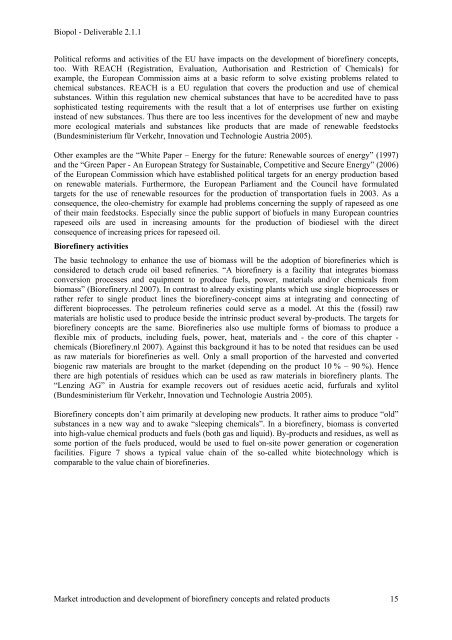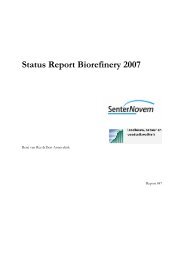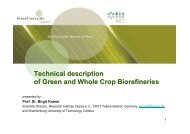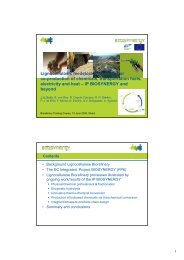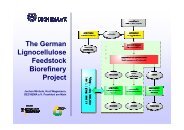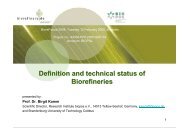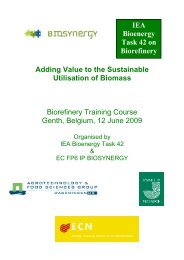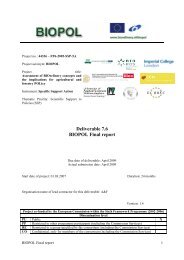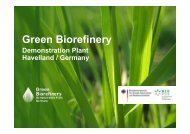D 2.1.1 Note on literature review concerning market ... - Biorefinery
D 2.1.1 Note on literature review concerning market ... - Biorefinery
D 2.1.1 Note on literature review concerning market ... - Biorefinery
Create successful ePaper yourself
Turn your PDF publications into a flip-book with our unique Google optimized e-Paper software.
Biopol - Deliverable <str<strong>on</strong>g>2.1.1</str<strong>on</strong>g><br />
Political reforms and activities of the EU have impacts <strong>on</strong> the development of biorefinery c<strong>on</strong>cepts,<br />
too. With REACH (Registrati<strong>on</strong>, Evaluati<strong>on</strong>, Authorisati<strong>on</strong> and Restricti<strong>on</strong> of Chemicals) for<br />
example, the European Commissi<strong>on</strong> aims at a basic reform to solve existing problems related to<br />
chemical substances. REACH is a EU regulati<strong>on</strong> that covers the producti<strong>on</strong> and use of chemical<br />
substances. Within this regulati<strong>on</strong> new chemical substances that have to be accredited have to pass<br />
sophisticated testing requirements with the result that a lot of enterprises use further <strong>on</strong> existing<br />
instead of new substances. Thus there are too less incentives for the development of new and maybe<br />
more ecological materials and substances like products that are made of renewable feedstocks<br />
(Bundesministerium für Verkehr, Innovati<strong>on</strong> und Technologie Austria 2005).<br />
Other examples are the “White Paper – Energy for the future: Renewable sources of energy” (1997)<br />
and the “Green Paper - An European Strategy for Sustainable, Competitive and Secure Energy” (2006)<br />
of the European Commissi<strong>on</strong> which have established political targets for an energy producti<strong>on</strong> based<br />
<strong>on</strong> renewable materials. Furthermore, the European Parliament and the Council have formulated<br />
targets for the use of renewable resources for the producti<strong>on</strong> of transportati<strong>on</strong> fuels in 2003. As a<br />
c<strong>on</strong>sequence, the oleo-chemistry for example had problems c<strong>on</strong>cerning the supply of rapeseed as <strong>on</strong>e<br />
of their main feedstocks. Especially since the public support of biofuels in many European countries<br />
rapeseed oils are used in increasing amounts for the producti<strong>on</strong> of biodiesel with the direct<br />
c<strong>on</strong>sequence of increasing prices for rapeseed oil.<br />
<strong>Biorefinery</strong> activities<br />
The basic technology to enhance the use of biomass will be the adopti<strong>on</strong> of biorefineries which is<br />
c<strong>on</strong>sidered to detach crude oil based refineries. “A biorefinery is a facility that integrates biomass<br />
c<strong>on</strong>versi<strong>on</strong> processes and equipment to produce fuels, power, materials and/or chemicals from<br />
biomass” (<strong>Biorefinery</strong>.nl 2007). In c<strong>on</strong>trast to already existing plants which use single bioprocesses or<br />
rather refer to single product lines the biorefinery-c<strong>on</strong>cept aims at integrating and c<strong>on</strong>necting of<br />
different bioprocesses. The petroleum refineries could serve as a model. At this the (fossil) raw<br />
materials are holistic used to produce beside the intrinsic product several by-products. The targets for<br />
biorefinery c<strong>on</strong>cepts are the same. Biorefineries also use multiple forms of biomass to produce a<br />
flexible mix of products, including fuels, power, heat, materials and - the core of this chapter -<br />
chemicals (<strong>Biorefinery</strong>.nl 2007). Against this background it has to be noted that residues can be used<br />
as raw materials for biorefineries as well. Only a small proporti<strong>on</strong> of the harvested and c<strong>on</strong>verted<br />
biogenic raw materials are brought to the <strong>market</strong> (depending <strong>on</strong> the product 10 % – 90 %). Hence<br />
there are high potentials of residues which can be used as raw materials in biorefinery plants. The<br />
“Lenzing AG” in Austria for example recovers out of residues acetic acid, furfurals and xylitol<br />
(Bundesministerium für Verkehr, Innovati<strong>on</strong> und Technologie Austria 2005).<br />
<strong>Biorefinery</strong> c<strong>on</strong>cepts d<strong>on</strong>’t aim primarily at developing new products. It rather aims to produce “old”<br />
substances in a new way and to awake “sleeping chemicals”. In a biorefinery, biomass is c<strong>on</strong>verted<br />
into high-value chemical products and fuels (both gas and liquid). By-products and residues, as well as<br />
some porti<strong>on</strong> of the fuels produced, would be used to fuel <strong>on</strong>-site power generati<strong>on</strong> or cogenerati<strong>on</strong><br />
facilities. Figure 7 shows a typical value chain of the so-called white biotechnology which is<br />
comparable to the value chain of biorefineries.<br />
Market introducti<strong>on</strong> and development of biorefinery c<strong>on</strong>cepts and related products<br />
15


